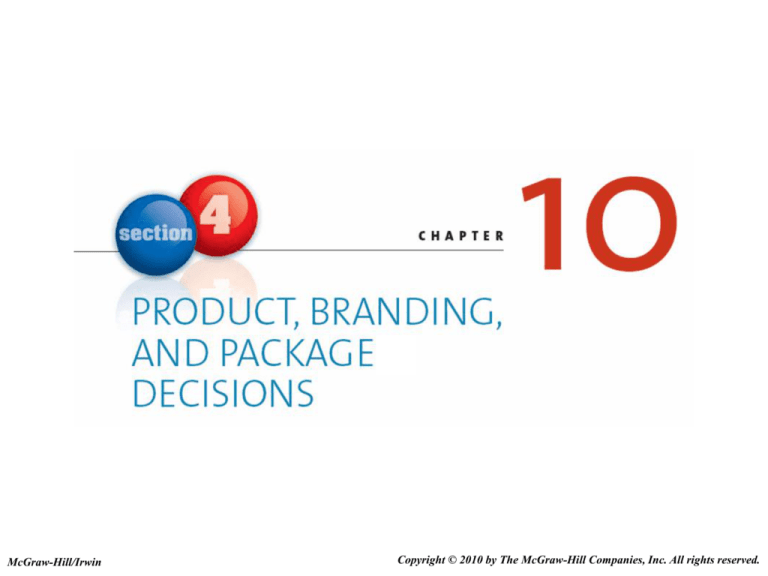
McGraw-Hill/Irwin
Copyright © 2010 by The McGraw-Hill Companies, Inc. All rights reserved.
Learning Objectives
LEARNING OBJECTIVES
How do firms adjust their product lines to
changing market conditions?
Why are brands valuable to firms?
How do firms implement different branding
strategies?
How do a product’s packaging and label
contribute to a firm’s overall strategy?
© McGraw-Hill Companies, Inc., McGraw-Hill/Irwin
10-2
iPod Anticipation
© McGraw-Hill Companies, Inc., McGraw-Hill/Irwin
10-3
Air Jordan
•
Moved beyond athletic
endorsement to
creation of entire line
•
NBA fees fueled
interest
•
Priced at $125
Nike/Air Jordan Website
© McGraw-Hill Companies, Inc., McGraw-Hill/Irwin
10-4
Product Assortment and
Product Line Decisions
© McGraw-Hill Companies, Inc., McGraw-Hill/Irwin
10-5
Product Assortment and
Product Line Decisions
Breadth
•Number of product lines
© McGraw-Hill Companies, Inc., McGraw-Hill/Irwin
Depth
•Number of categories within
a product line
10-6
Change Product Mix Breadth
•
Increase Breadth
–
•
True Religion Brand Jeans
now are a lifestyle brand
with apparel, belts,
swimwear and fragrances
Decrease Breadth
–
Due to competitive
changes, TCBY is now
focusing on Yogurt.
© McGraw-Hill Companies, Inc., McGraw-Hill/Irwin
10-7
Change Product Mix Depth
Increase Depth
Band-Aid now has over
40 products to heal
cuts.
Decrease Depth
McCormick spices
eliminates dozens of
products each year.
© McGraw-Hill Companies, Inc., McGraw-Hill/Irwin
10-8
Product Line Decisions
How is this changing
the product mix?
Does it increase
breadth or depth?
Is this research or
advertising?
© McGraw-Hill Companies, Inc., McGraw-Hill/Irwin
10-9
Within each product line, there are often
multiple:
A.
product categories.
B.
primary packaging parts.
C.
product breadth.
D.
product assortment.
E.
private label brands.
© McGraw-Hill Companies, Inc., McGraw-Hill/Irwin
10-10
Product Line Decisions for Services
The same types of decisions can be used for services
© McGraw-Hill Companies, Inc., McGraw-Hill/Irwin
10-11
Check Yourself
1.
Why change product line depth?
2.
What is the difference between product
line breadth versus depth?
3.
Why change product line breadth?
© McGraw-Hill Companies, Inc., McGraw-Hill/Irwin
10-12
Branding
A brand can use: Name, logo symbols, characters,
slogans, jingles and even distinctive packages.
Oscar Meyer Commercial
© McGraw-Hill Companies, Inc., McGraw-Hill/Irwin
10-13
What Makes a Brand?
Logos and
symbols
Slogans
URLs
Brand
name
Characters
Branding
© McGraw-Hill Companies, Inc., McGraw-Hill/Irwin
Jingles
10-14
Value of Branding for the
Customer and the Marketer
Facilitate Purchasing
Establish Loyalty
Protect from Competition
Reduce Marketing Costs
Are Assets
Impact Market Value
© McGraw-Hill Companies, Inc., McGraw-Hill/Irwin
10-15
History in Advertising
© McGraw-Hill Companies, Inc., McGraw-Hill/Irwin
10-16
Brand Equity: Awareness
© McGraw-Hill Companies, Inc., McGraw-Hill/Irwin
10-17
Brand Equity: Perceived Value
How do discount
retailers like Target,
T.J. Maxx, and H&M
create value for
customers?
© McGraw-Hill Companies, Inc., McGraw-Hill/Irwin
10-18
Brand Equity: Brand Associations
© McGraw-Hill Companies, Inc., McGraw-Hill/Irwin
10-19
One of the dangers of hiring celebrities like Mel Gibson to endorse a
company’s products is that when they engage in embarrassing behavior, to the
degree that they are associated with the company’s brands, their actions hurt:
A.
brand equity.
B.
brand awareness.
C.
brand recognition.
D.
corporate brand category depth.
E.
all of the above.
© McGraw-Hill Companies, Inc., McGraw-Hill/Irwin
10-20
Brand Equity: Brand Loyalty
Consumers are often
less sensitive to price
Marketing costs are
much lower
Firm insulated from the
competition
© McGraw-Hill Companies, Inc., McGraw-Hill/Irwin
10-21
Check Yourself
1.
How do brands create value for the
customer and the firm?
2.
What are the components of brand equity?
© McGraw-Hill Companies, Inc., McGraw-Hill/Irwin
10-22
Brand Ownership
Private-label brands or
Store Brands
Manufacturer brands
or national brands
© McGraw-Hill Companies, Inc., McGraw-Hill/Irwin
•Premium
•Generic
•Copycat
•Exclusive co-branded
10-23
Brand Ownership
Private Label
© McGraw-Hill Companies, Inc., McGraw-Hill/Irwin
10-24
Brand Ownership
Exclusive Co-brands
© McGraw-Hill Companies, Inc., McGraw-Hill/Irwin
10-25
Naming Strategies
Corporate or family
brand
The Gap
Corporate and product
line brands
Individual lines
Mr. Clean (Proctor &
Gamble)
Kellogg’s Corn Flakes
© McGraw-Hill Companies, Inc., McGraw-Hill/Irwin
10-26
Brand Extension
State Farm Website
© McGraw-Hill Companies, Inc., McGraw-Hill/Irwin
10-27
Which of the following is a potential
benefit of brand extension?
A.
It allows the perception of a brand with a
quality image to be carried over to the new
product.
B.
It lowers marketing costs.
C.
It can boost sales of the core brand.
D.
The firm can spend less on creating brand
awareness and associations.
E.
all of the above.
© McGraw-Hill Companies, Inc., McGraw-Hill/Irwin
10-28
Brand Dilution
Evaluate the fit between
the product class
of the core brand
and the extension.
Evaluate consumer
perceptions of the
attributes of the core
brand
and seek out extensions
with similar attributes.
Refrain from
extending the brand
name to too many
products.
Is the brand
extension distanced
enough from the
core brand?
© McGraw-Hill Companies, Inc., McGraw-Hill/Irwin
10-29
Co-branding
© McGraw-Hill Companies, Inc., McGraw-Hill/Irwin
10-30
Brand Licensing
© McGraw-Hill Companies, Inc., McGraw-Hill/Irwin
10-31
Brand Repositioning
How is this
repositioning?
© McGraw-Hill Companies, Inc., McGraw-Hill/Irwin
10-32
Check Yourself
1.
What is the difference between
manufacturer, private/label, and generic
brands?
2.
What is co-branding?
3.
What are some advantages and
disadvantages of brand extensions?
© McGraw-Hill Companies, Inc., McGraw-Hill/Irwin
10-33
Packaging
What other packaging
do you as a consumer
find useful?
© McGraw-Hill Companies, Inc., McGraw-Hill/Irwin
10-34
Chianti that comes in wicker-clad bottles and tortillas that come in zip lock
bags are examples of brand _____________ that differentiate these companies’
products from their competitors’ offerings.
A.
names
B.
slogans
C.
symbols
D.
characters
E.
packaging
© McGraw-Hill Companies, Inc., McGraw-Hill/Irwin
10-35
Product Labeling
© McGraw-Hill Companies, Inc., McGraw-Hill/Irwin
10-36
Glossary
A brand association reflects the mental links that
consumers make between a brand and its key
product attributes, such as a logo, slogan, or
famous personality.
Return to slide
© McGraw-Hill Companies, Inc., McGraw-Hill/Irwin
10-37
Glossary
Brand dilution occurs when the brand extension
adversely affects consumer perceptions about the
attributes the core brand is believed to hold.
Return to slide
© McGraw-Hill Companies, Inc., McGraw-Hill/Irwin
10-38
Glossary
Brand equity is the set of assets and liabilities linked
to a brand that add to or subtract from the value
provided by the product or service.
Return to slide
© McGraw-Hill Companies, Inc., McGraw-Hill/Irwin
10-39
Glossary
A brand extension refers to the use of the same
brand name for new products being introduced to
the same or new markets.
Return to slide
© McGraw-Hill Companies, Inc., McGraw-Hill/Irwin
10-40
Glossary
Brand licensing is a contractual agreement between
firms, whereby one firm allows another to use its
brand name, logo, symbols, and/or characters in
exchange for a negotiated fee.
Return to slide
© McGraw-Hill Companies, Inc., McGraw-Hill/Irwin
10-41
Glossary
Brand loyalty occurs when a consumer buys the
same brand’s product or service repeatedly over
time rather than buy from multiple suppliers
within the same category.
Return to slide
© McGraw-Hill Companies, Inc., McGraw-Hill/Irwin
10-42
Glossary
Brand repositioning or rebranding refers to a
strategy in which marketers change a brand’s
focus to target new markets or realign the brand’s
core emphasis with changing market preferences.
Return to slide
© McGraw-Hill Companies, Inc., McGraw-Hill/Irwin
10-43
Glossary
Co-branding is the practice of marketing two or
more brands together, on the same package or
promotion.
Return to slide
© McGraw-Hill Companies, Inc., McGraw-Hill/Irwin
10-44
Glossary
Perceived value of a brand is the relationship
between a product or service’s benefits and its
cost.
Return to slide
© McGraw-Hill Companies, Inc., McGraw-Hill/Irwin
10-45
Glossary
Product assortment or product mix is the complete
set of all products offered by a firm.
Return to slide
© McGraw-Hill Companies, Inc., McGraw-Hill/Irwin
10-46
Glossary
Product lines are groups of associated items, such
as items that consumers use together or think of
as part of a group of similar products.
Return to slide
© McGraw-Hill Companies, Inc., McGraw-Hill/Irwin
10-47
Glossary
Product mix or product assortment is the complete
set of all products offered by a firm.
Return to slide
© McGraw-Hill Companies, Inc., McGraw-Hill/Irwin
10-48






